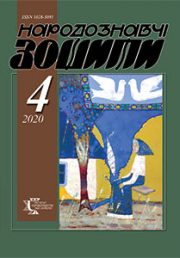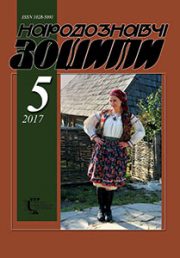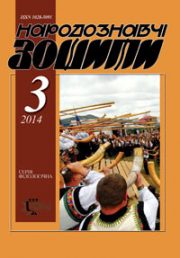The Ethnology Notebooks. 2019, № 6 (150), 1708—1720
UDK[7.038.6+008](477.86-25)”198″
Б12
DOI https://doi.org/10.15407/nz2019.06.1708
BABII Nadia
ORCID ID: https://orcid.org/0000-0002-9572-791X
Assistant Professor of the department of design
and art theory of Precarpathian National University.
Ivano-Frankivsk 57, Т. Shevchenko Str., 76000
e-mail: nbabij26@gmail.com
Abstract. The study is focused on the investigation of regional non-academic cultural and artistic processes of the late XX-th century, their role in the development of modern visual art culture of Ivano-Frankivsk and its place in the Ukrainian cultural space. Non-academic artistic work is seen as one of the driving forces of cultural development, which is in conflict with the official art (including folk). The desire for change, the search for new forms, the critique of reality were reflected in the multifaceted phenomena of the turn of the epochs, and the cultural and artistic creative work turned out to be between the past and the future, «classic» and postmodernism.
Objectives. To explore the nature of interaction between the academic and alternative forms of art in Ivano-Frankivsk at the end of the twentieth century, which reveal the dialogue of personality with the national folk art. In order to reach this objective it is necessary to compare the artistic work of the artists whose individual style has been influenced by folk art, to indicate their affiliation with the Ivano-Frankivsk artistic establishments, and to determine the degree of their interactions with each other.
Method. The research is based on general principles of research standards. These include, in particular, the integrated and systemic principle, the standards of historicism, objectivity and comprehensiveness.
The cultural approach helps to highlight the tendency towards the national art as a primary source embodied in the works of various genres of the artists of Ivano-Frankivsk region of the period of the 1980s and 1990s. The main research methods are analysis, synthesis and comparison. Diachronic appeals and synchronous methods have made it possible to identify links between the aesthetic orientation of contemporary art and social, national, and global artistic trends.
Results. Within the narrow environment of Ivano-Frankivsk at the end of the twentieth century, a plethora of artistic forms was observed, revealing a dialogue of personality with the collective model of creativity.
The manifestations of these processes are observed both in academic and alternative arts: «picture» exhibitions are amplified by video art, performances, literary readings, so the interaction of «one’s own» and «the other» generates many unexpected forms. While not recognizing the value of academic art, artists of the new generation often use secondary quotations, which are unfortunately not mentioned in curatorial comments.
The absence of a modern centralized strategy for the development of art and culture deepens the polarization and leads to negative regressive consequences.
Keywords: Ivano-Frankivsk, perception of national heritage, professional artists, «Stanislav phenomenon», underground, postmodernism.
Received 5.11.2019
REFERENCES
Barthes, R. (1989). Izbrannye-raboty: Semiotika: Pojetika. Moskva: Progress [in Russian].
Petrova, O. (1991). About perception of national heritage by a professional artist. In Art reflections. Burn this book (pp. 13—21). Kyiv: Akademiia [in Ukrainian].
Petrova, O. (1999). Dialogues with the «third culture». In Art reflections. Burn this book (pp. 13—21). Kyiv: Akademiia [in Ukrainian].
Holubets, O. (2010). Search of national roots or postmodernist destruction. Art studies`10 (pp. 23—29). Lviv [in Ukrainian].
Zvizhyns’kyj, A. Stanislav Ivano-Frankivs’k and his art. Retrieved from: https://zbruc.eu/node/77654 (Last accessed: 17.09.2019).
Dejchakivs’ka, S. Frankivsk. The city of private experiences of Taras Prokhasko. Retrieved from: http://report.if.ua/kultura/ya-spryjmayu-ce-misto-yak-albom-pryvatnyh-perezhyttiv-prohasko-pro-frankivsk-jogo-atmosferu-i-porazky/ (Last accessed: 14. 09.2019) [in Ukrainian].
Linda, S.M. (2012). The structure of the «architectural sign» and the «architectural texture» in semiotic analytical documents of historicism. Visnyk Natsional’noho universytetu «L’vivs’ka politekhnika». Seriia: Arkhitektura, 728, 14—25 [in Ukrainian].
Kardash, N. (2012). The seventh window. In The nominative case. Independent Art of Ivano-Frankivsk 1990s—2000s. Texts, visions, personalities. Burn this book (pp. 23—24). Ivano-Frankivs’k: ArtHuss [in Ukrainian].
Pro zakhody po vykonanniu v respublitsi postanovy TsK KPRS «Pro narodni khudozhni promysly». Postanova Tsentral’noho Komitetu Kompartii Ukrainy i Rady Ministriv Ukrains’koi RSR vid 25 bereznia 1975 r. № 149. Retrieved from: http: // www.search.ligazakon.ua/l_doc2.nsf/link1/KP750149.html (Last accessed: 13.09.2019) [in Ukrainian].
Sokolovs’kyj, Z. (2014). Arkhitektory radians’koho Ivano-Frankivs’ka. Ivano-Frankivs’k: Lileia NV [in Ukrainian].
Zvizhyns’kyj, A. Impreza. Memories and reflections. Retrieved from: https://zbruc.eu/node/14286 (Last accessed: 18.09.2019).
Babiі, N. (2017). Design of polygraphy of the late 1990s. Regional development factors (Proceedings of the International Scientific Conference «Carpathian art in the socio-cultural space of Ukraine»). Ivano-Frankivs’k [in Ukrainian].
Zvizhyns’kyj, A. (2018). Hutsul’s’kyj siurrealist i mol’far kol’oru — frankivs’kyj khudozhnyk Yaroslav Yanovs’kyj. City, Retrieved from: https://mi100.info/2018/05/13/hutsulskyj-syurrealist-i-molfar-koloru-frankivskyj-hudozhnyk-yaroslav-yanovskyj/ (Last accessed: 13.09.2019) [in Ukrainian].
Hajmus, I. (2019) Genesis-1 in Lutsk presented informal Frankivsk. Retrieved from: https://zbruc.eu/node/88921 26.04.2019 (Last accessed: 15.09.2019).
Ternopolianam pokazhut’ vystavku hutsul’s’koi erotyky «Friklektyka + 18». Retrieved from: https://te.20minut.ua/Vystavky/ternopolyanam-pokazhut-vistavku-gutsulskoyi-erotiki-friklektika-18-10499220.html (Last accessed: 16.092019) [in Ukrainian].
Babij, I. U nashykh muzeiakh — tsarstvo moli, — khudozhnyk Serhij Hryhorian. Retrieved from: http://gk-press.if.ua/u-nashyh-muzeyah-tsarstvo-moli-hudozhnyk-sergij-grygoryan/ (Last accessed: 16.09.2019) [in Ukrainian].
Zvizhyns’kyj, A. (2014). Volodymyr Humennyj and his artistic cosmogony. Retrieved from: https://zbruc.eu/node/ 19888 (Last accessed: 13.09.2019).
Zvizhyns’kyj, A. (2015). Igor Pereklita about art daily struggle. Retrieved from: https://zbruc.eu/node/36958 (Last accessed: 17.09.2019).
Yanovs’kyj, Y. Shevchenko and landscape. Retrieved from: http://artmedium.com.ua/archives/5476 (Last accessed: 18.09.2019) [in Ukrainian].
Drabchuk, I. (2014) Sword and Ralo are symbols of the Galician land. Retrieved from: http://www.galslovo.if.ua/index_old.php?st=4210 (Last accessed: 16.09.2019) [in Ukrainian].
Vasily Andrushko — artist, sculptor, poet. Retrieved from https://www.youtube.com/watch?v=_aCIjkjzEgM (Last accessed: 18.09.2019).
Pastukh, T. Oleg’s Lysheha red ocher. Retrieved from: http://litakcent.com/2011/03/29/chervona-vohra-slova-oleha-lyshehy/ (Last accessed: 17.09.2019) [in Ukrainian].
Zhyla, O. Poetry in sculpture. Retrieved from: https://h.ua/story/147548/ (Last accessed: 17.09.2019) [in Ukrainian].






